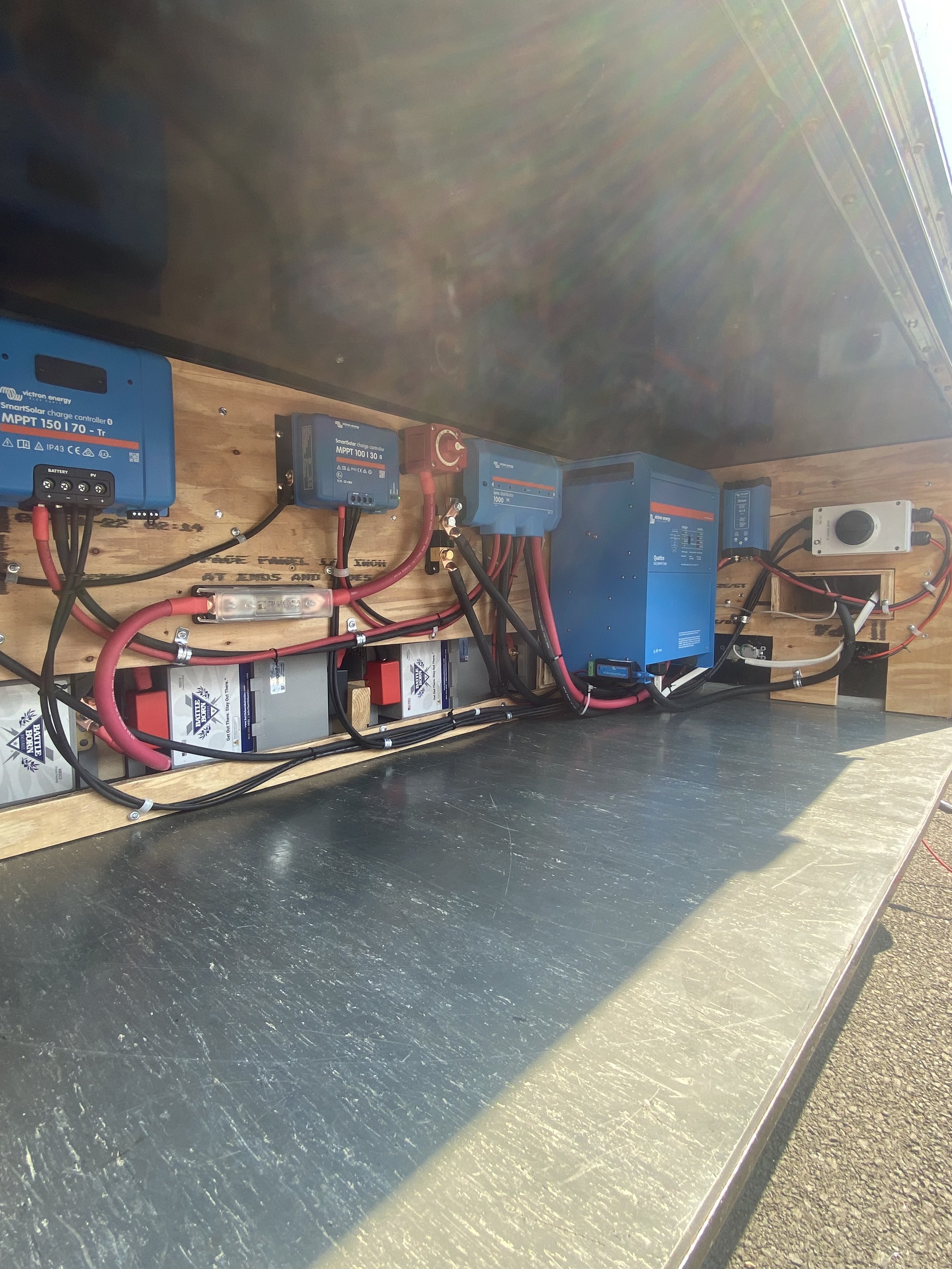12 Volt System vs 24 Volt System, Off-Grid Electrical Systems
In our consulting calls with clients we talk a lot about power usage. We ask the question, what are you looking to power off of your system? Usually the conversation will start with the normal creature comforts: fridge, LED lights, MaxAir fan, stovetop, heater, and charging for devices such as phone, computer, and camera. For some this is where the list starts to slow down, some stop here, but when we let a pause hang in the question our client will slowly start to list more items they desire to use.
As we live our lives with our iPhone plugged in, charging our headphones, making a smoothie, and doing laundry all at the same time, we don't always think about the connection to the power these items draw nor the necessity of it. That is one of the greatest joys in building an off-grid electrical system: you get to decide what is necessary for you to live sustainably. You get to ask yourself the question: what electrical products do I truly need and value in this adventure? For one of our clients, who is preparing to live on the road in a 40 foot school bus with a family of 4 and is bringing a deep sense of value to their travel, a high powered electrical solution is needed.
We all have different electrical needs, all with differing electrical solutions. Everyone’s situation is different and these varying needs have varying solutions. While design and cost are certainly important factors, safety of these systems is an absolute necessity.
For our client, their goal was to build an electrical system that would keep themselves and their family self-sustainable, able to process wild harvested produce in the bus, have the comfort of doing their own laundry within the bus, as well as have enough power to help build off-grid permaculture communities. They were working towards an incredible sustainable lifestyle while also investing their energy into a larger community. We were excited to help!
We knew we would need a lot of solar, a large battery bank, and a lot of inverting power. And we then asked ourselves the question, is this a good candidate for a 24 volt system? This prompted our conversation of why we would use a 12/24/48 volt for a particular system? We highlighted a list of questions to walk through to decide between a 12 volt of 24 volt system.
Questions to ask when deciding between a 12 volt, 24 volt, or 48 volt system?
We started the discussion by working through a series of questions.
How far are the components from one another?
How much power is actually going to be pushed through the system?
How much solar power are we planning on installing?
What voltage are most of the devices or components using?
Are there goals to grow the system?
Are there goals to move the system in the future?
The big players that impact if your system will be a good candidate for a 24 volt system is the combination of the size of your solar array, a larger space with components further apart from one another (long runs of wire), the desire to grow the system in the future both in power and in space, voltage used by appliances, type and size of batteries used, and the desire to have over 3000W of inverting power.
For this family of four, we decided on 5000 Watts of inverting power, 1800 watts of solar on the roof with an additional 350 Watt deployable solar array, plus a 50 amp shore power charging port. Due to the large space, components were fairly spread out in this build, leading us towards the answer of, “let’s build a 24 volt system!”.
Let’s take a step back and find our ‘ground’ in this conversation to cover in more detail how we got to the answer of building a 24 volt system.
We will start with the basics.
What are Volts?
Volts are essentially a measure of the electrical pressure, very much akin to the water pressure in your household plumbing. A 12v system has less electrical ‘pressure’ or ‘force’ then 24 or 48v systems. A 48 volt system is your faucets on full blast. Because of this, the higher voltage systems are able to deliver more electricity (amps) in a given size of wire (think diameter of your household plumbing).
Voltage and Wire Size
Well, wire size does matter.
Wire sizing is where this difference in amps comes into play. If our DC (direct current) wires running to our 24v AC Unit (1800W) were 10ft long, and we were assuming a 3% voltage drop (using high quality wire), the wire gauge needed to safely power that stove is very different in these two situations:
In a 12v system, big ol’ 2/0 wires (0.36in or 10mm diameter) are needed to power the AC unit as well as the converter at the end. Approximate cost for 2/0 wire is $4.32/ft.
In a 24v system, the wires would be safely sized at 2 AGW. The approximate cost for 4/0 wire is $2.20/ft.
Over that 10ft distance, using a 24v system will save you $21.20. That’s not too much, but extrapolating this minimized wire size to EVERY 24v connection within a system can add up quickly.
$21.20 of savings was just for the 24v AC unit.
Why not always use 24v?
There are positive and negatives to both the 12 volt system and the 24 volt system.
For a 12 volt system, you can use just one battery although you will need larger wire sizes. While the battery draw on a 12 volt system is a bit less efficient due to the hight amperage draw, you would not need to purchase extra components for DC-DC conversion.
The greatest downside we see to the 12 volt system is the size of your solar array. There is a limit to the size of the solar array going into the MPPT controller which sits around 1450 Watts. With a 12 volt system you would need to install an additional solar charge controller which is an additional cost.
For a 24 volt system you can plan on using smaller wires which does cut back on the cost, although you will most likely need a 24 volt to 12 volt converter for any 12 volt devices. If you are planning on spacing out your Victron components in your build (as we were in the bus build) then the cost savings of the wire will add up!
The plus side to a 24 volt system is that the solar controllers can be more efficient and less expensive, definitely if you are building a larger solar array. A 24 volt system is also a great option if you are looking to transfer your system to an off-grid home or cabin in the future.
What about 48v systems?
More is better, right? Following the logic above, yes. Unfortunately, there becomes a limitation of components that are normally tuned to the 12/24 volt systems. Switches, DC to DC converters, fuses, and more get harder to source from trusted sources. These types of systems are generally used for off-grid situations where there isn’t any need for 12 volt, so the 48 volts gets solely used to invert up to 120/240VAC. The amount of power you can transfer through 48v is incredible, but the application needs to make sense to make it worthwhile.
So, what system do I choose?
First off, we are here to help. We offer free 30-minute consultations to help you answer any questions you have about your electrical system! We have been approached by many people who ask “I want to have a reliable electrical system for my van, but I just bought a property that I want to make an off grid lifestyle. Can we find a system that allows us to move from one to the other?” The answer is a resounding YES!
From our experience and our knowledge, the best reason we see for a 24 volt system is solar array sizing. If you plan on a solar array now or in the future larger than 1450 Watts, a 24 volt system is going to be your best path forward unless you want to buy multiple MPPT solar chargers (cha-CHING!).
Another primary reason to look into a 24 volt system is the future growth of the system. If you see yourself growing your electrical system or moving it into an off-grid home scenario in the next 5 years or so, we would recommend you looking into a 24-48 volt system (knowing you can add battery capacity and up to 48v with certain considerations). If you are looking in the future and seeing the application of van life influence future off-grid living situations in your life, then why not design an electrical system that will move with you through those life stages?
All in all, it’s your choice to make based on your electrical needs and the comforts you value. While some of us are happy with a jetboil, others really desire an induction cooktop. While some of us are planning to take our van electrical system out to play a DJ set in the desert , others will be secluded in the woods soaking in the silence. And while some of us know we want to clean our children's clothes while building a new permaculture community, others will be wanting their Webasto heater to turn on and dry their snow gear after an epic day on the mountain.
The beauty of choosing an alternative lifestyle is that it gives you the opportunity to think about what you value and need in your electrical system. We are all going to do it a little bit differently, but as long as the system powers your desired adventures, that is all that matters!
Still debating what size electrical system to install in your camper? Schedule a free 30-minute consult with us today! Looking to install a 24 Volt system into your adventure vehicle? Check out our Full-Timer electrical package!
Want to dive in even deeper into system sizes? We recommend checking out Explorist.Life’s YouTube video on 12V vs 24V vs 48V for campers!
We look forward to helping you design and install the most sustainable off-grid electrical system for your needs! Please connect with us today to share your project and off-grid electrical goals!
Cheers!
Morgan & Ira






